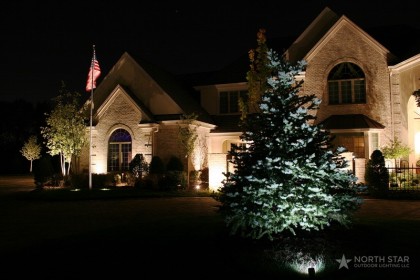
The right outdoor lighting can enhance the appearance of any space, with different looks achieved based on the types of lighting and effects used, as well as the features of your outdoor environment. While a lighting expert will be able to guide you in choosing the best outdoor lighting for your property, understanding the various types of effects can help you start envisioning how your outdoor space will look when properly illuminated. At North Star, we’ve compiled the following overview of different outdoor lighting effects.
Directional Lighting
Directional lighting focuses on illuminating the essential items in your outdoor space. Therefore, you need to choose appropriate light sources to ensure safety and adequate brightness.
When incorporating directional lighting into your landscape, ensure that you consider the shadow effects of the lamps when placing them to avoid any blind spots or inadequate lighting. It would also help to consider the plants in the surroundings, which will guide you in where and how you place the differently colored lamps with their specific lumens. Looking at the surfaces and textures of the targeted areas will help you determine which types of lights to buy and install.
Up Lighting
If you want to highlight the landscape and architectural design in your outdoor space, up lighting will work well. It focuses on directing light from the ground level upwards to illuminate the beautiful design features in your outdoor spaces.
The challenge with up lighting is choosing an appropriate lighting angle that will bring out the area’s natural beauty. It may also help to consider lighting pollution through light spillage into some of the rooms in your house. Finally, consider the landscaping of the area during the different seasons, and use appropriate lamps and fixture shields to curb potential landscaping and spillage issues.
Down Lighting
Down lighting focuses on illuminating the outdoor space from above. It tends to be more immune to changing weather and landscaping patterns than up lighting, and will provide both functional and aesthetic appeal.
Down lighting can be installed on your patio or any other hanging structure to cast the light across the intended area. With proper placement, you’ll be able to achieve the desired effects with low voltage bulbs.
Spot Lighting
Spot lighting highlights a specific object or feature in your outdoor space. You will have to install a directional lamp to focus on the item without having light spillage into other areas. Also, watch out for excessive light, which might cause glare or undesirable shadows.
Area Lighting
You can use area lighting if you want to illuminate a large area. It is a straightforward type of lighting, but you must choose the appropriate light bulb color and wattage in order to cover the entire region with the desired effect. Also, consider the purpose of your outdoor space—for example, an outdoor party area may need a multifaceted reflector to give the place a festive vibe.
Shadowing
Shadowing introduces the concept of using dark and light to create a unique design in your outdoor space. You can use directional, spot, or up lighting with shadowing to get the desired effect. Focusing light upwards on an object can create a more profound effect, while you can use a wall or fence as the background for the shadow.
Silhouetting
Many people use shadows and silhouettes interchangeably. However, shadowing focuses on creating shadows from objects, while silhouettes create outlines.
Security Lighting
As the name suggests, security lighting is intended to enhance safety and security at a home or commercial building. You’ll want to illuminate the entire perimeter and eliminate blind spots, focusing especially on walkways and entryways.
Pathway Lighting
Pathway lighting offers many ways to enhance the aesthetic appeal, as well as the safety, of your outdoor space. To help prevent trips and falls, it’s important to choose lighting that will make your pathways more visible. Lights should also be installed at least at knee height level to provide the correct depth perception. In addition, avoid glaring lights as they can deceive the users.
Many people also use pathway lighting to create an enchanting glow along the paths leading up to their home or business.
Step Lighting
Step lighting specifically illuminates the steps in your walkways. LEDs are often on each step in order to increase safety.
Moonlighting
Do you enjoy the moon’s illumination in your outdoor space? If the trees and other objects prevent natural moonlight from fully reaching your property, moonlighting may help recreate the effect. For example, installing lamps within tree branches can simulate the calming effect of moonlight. You can also adjust the lamp’s brightness by changing its proximity to the ground: a lower position will increase the brightness and concentration, while having it further away makes it dimmer. Ensure that you consider the weather and maintenance requirements of these lamps when installing them.
Underwater Lighting
Underwater lighting creates an alluring glow and enhances visibility within a pool, pond, fountain, or other body of water. Colored LEDs are a particularly popular choice for underwater lighting.




